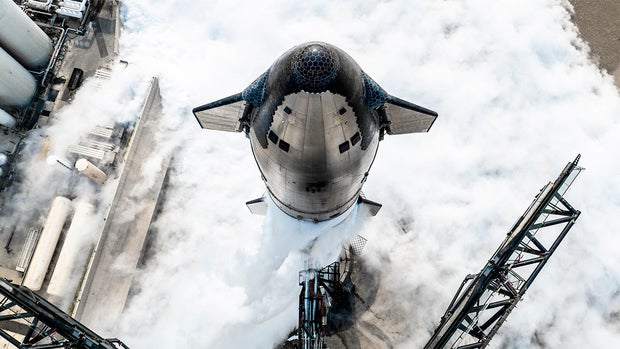
[ad_1]
Pressing ahead with an ambitious test schedule, SpaceX primed the world’s most powerful rocket for its fourth flight Thursday, an attempt to put the company’s Starship upper stage into space and then bring it back down through the heat of re-entry for a controlled splashdown in the Indian Ocean.
The flight plan also called for the gargantuan Super Heavy first stage booster to make a controlled descent to a “soft” landing in the Gulf of Mexico after propelling the Starship out of the lower atmosphere.
The two-hour launch window at SpaceX’s Boca Chica, Texas, “Starbase” facility was expected to open at 8 a.m. EDT. Mission duration, from start to finish: one hour and five minutes.
SpaceX
The 39-story-tall Super Heavy-Starship rocket is by far the most powerful launcher in the world with more than twice the liftoff thrust of the space shuttle, NASA’s legendary Apollo program Saturn 5 and the Space Launch System rocket designed for the agency’s Artemis moon rocket.
Powered by 33 methane-burning Raptor engines, the 230-foot-tall Super Heavy booster generates a staggering 16 million pounds of thrust. It is designed to propel the Starship upper stage out of the lower atmosphere before falling away for a rocket-powered descent to landing, refurbishment and reuse.
The 160-foot-tall Starship, powered by six Raptors, also is designed to be fully reusable, capable of tail-first landings back on Earth, on the moon or even Mars.
For the Super Heavy-Starship’s initial test flights, however, recovery was not an option. The goal was to “simply” get both stages back to the lower atmosphere intact and under control. For Thursday’s flight, both stages were programmed to attempt rocket-powered descents mimicking actual landing procedures. But both were expected to sink on impact.
“The fourth flight test turns our focus from achieving orbit to demonstrating the ability to return and reuse Starship and Super Heavy,” SpaceX said on its website. “The primary objectives will be executing a landing burn and soft splashdown in the Gulf of Mexico with the Super Heavy booster, and achieving a controlled entry of Starship.”
During three previous flights, two in 2023 and the most recent in March, the Super Heavy and Starship stages suffered catastrophic failures before all the test objectives could be met. But with each flight, SpaceX implemented hardware and software upgrades that resulted in dramatically improved performance.
SpaceX
In third test flight, the Starship upper stage made it into space, looped around the planet and began a planned descent over the Indian Ocean before breaking up in the upper atmosphere. The Super Heavy booster made it back into the lower atmosphere over the Gulf of Mexico before control was lost.
But SpaceX hailed the flight as an overall success and made more changes to improve performance during Thursday’s test.
Getting the Super Heavy-Starship flying on a regular basis is critical to NASA’s Artemis moon program. NASA awarded SpaceX a $2.9 billion contract in 2021 to develop a variant of the Starship upper stage to carry astronauts from lunar orbit down to the surface and back. Artemis crews will travel to and from the moon using Lockheed Martin-built Orion capsules.
To reach the moon, multiple Super Heavy tanker flights will have to be launched to robotically refuel a Starship upper stage already in low-Earth orbit. The Starship lander then will fly itself to lunar orbit to await the Artemis moonwalkers.
NASA’s contract requires one unpiloted lunar landing test flight before astronauts will make an actual landing attempt. Artemis managers are targeting late 2026 for the first lunar landing with astronauts on board.
But that will depend on SpaceX launching enough Super Heavy-Starship flights to demonstrate reliability. While SpaceX’s philosophy is to fly frequently, learn from mistakes and fly again, NASA will require a long string of successful flights before the agency will deem it safe to put astronauts aboard.
[ad_2]
Source link

